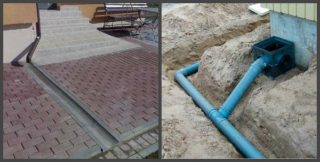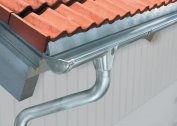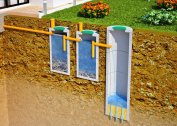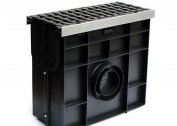High-quality exploitation of a land plot implies full disposal of ground and rain waters from it. In this case, moisture will not have a destructive effect on buildings and terrain. In the drainage of the land use special drainage systems for the suburban area. They vary in type and installation method.
When is a drainage system necessary?
Proper drainage of the site is necessary in such cases:
- clay and loamy soils on land allotted for ownership;
- high water table;
- high annual rainfall in the region;
- sloping terrain allotment or its location at the lowest point of the village.
It is possible to determine the soil problem by eye immediately after a prolonged rainfall or snowmelt. If the water stays on the surface for a long time, forms bogging, it means that a drainage system at the summer cottage is necessary.
Properly designed and installed drainage will ensure good growth of fruit / vegetable crops in the garden and in the garden.
Types and arrangement of drainage systems
Drainage for soil in the country is classified by the type of device:
- Open system (surface). The easiest option for drainage. Convenient for installation on level areas. Structurally, it is prepared and specially arranged along the perimeter of the trench grooves. They accumulate excess moisture, which in the future simply evaporates or flows into a special receiver. Such water can be used for irrigation. Outdoor drainage resembles standard stormwater.
- Depth system (closed). Drainage pipes are sloped in the thickness of the soil. Such communication is ideal for embossed, sloping, wetland or clay areas. As the main elements of the drainage system, special perforated pipes are used.
Indoor drainage is desirable to install at the stage of construction of the foundation of a country house, or at least before planting vegetables.
Preparatory work
The entire soil drainage system is a whole communication from series-connected trenches. Before laying the drainage pipes at the cottage with your own hands, it is advisable to prepare design documentation, at least in the form of a drawing, thanks to which it will subsequently be possible to navigate when servicing the system. The design documentation must indicate the most important points:
- linearity and location of drains;
- system depth;
- direction of outflow of water;
- location points of inspection wells (for a closed system);
- drainage slope level;
- end point of water collection.
In addition to documentation, you need to prepare pipes / wells (for deep drainage) and a working tool. Drains for a summer cottage can be taken with a cross section of 60 to 110 mm, depending on the estimated volume of water discharged. Couplings, sand and gravel should also be prepared.
Methods of installing a drainage system in a summer cottage
 Deep drainage system
Deep drainage system
The most time-consuming method of drainage is deep. Perform the work in the following sequence:
- According to the project, trenches are prepared for pipe laying. Their bottom should be even, with a depth below groundwater level of 20 cm. On average, loam deepens to 90 cm, on clay soil - to 60-70 cm.In this case, it is necessary to observe a slope of 5-7 mm per meter of the length of the system so that the water leaves by gravity.
- The bottom of the trench is covered with a sand pad 10-12 cm thick. The layer is well rammed.
- A geotextile is laid on top of a sand cushion so that its edges rise 30-40 cm up.
- A layer of fine-grained gravel is poured onto the filter pad and pipes are laid. All sleeves are connected in series with couplings and adapters during turns / forks.
- Pipes are covered with rubble and wrapped in geotextiles.
- Now you can dig trenches, but do not tamp the ground. She will settle herself over time.
To avoid painstaking work, it is better to buy ready-made drainage pipes in a geotextile filter. Such a fabric passes water into the system, but prevents the ingress of earth and sand. As a result of communication, there is no danger of blockages and siltation.
 Open drainage system
Open drainage system
This type of drainage is built on the principle of closed, but the trenches do not dig deep - 40-50 cm are enough. They are located on the surface of the site and are constantly open for revision. As sewage channels, standard plastic bottles can be used, cut along and without a neck / bottom. Thus, they are a kind of trays for collecting and discharging rainwater. It is enough to connect them together with adhesive tape.
The process of work on the device of open drainage looks like this:
- Prepare trenches for laying trays. They are made with gently sloping walls for free flow of water and always with a slope of about 5 mm per meter of communication length. It is desirable to strengthen the walls of the trenches with slate or other improvised material.
- The bottom is covered with a sand pillow.
- Trays prepared from pipes are laid on it. You can simply cover the bottom of the ditches with broken bricks or large pebbles.
Such a system is simple in the device, but spoils the appearance of the site.
Operation and maintenance of drainage in the country
In order for the drainage in the country to work properly, it is important to properly care for it. It is necessary to regularly (every 5-7 years) carry out special cleanings in two possible ways:
- Flushing. It is carried out under high pressure. To do this, the end of the drainage pipe is brought out with the help of the sleeves. On the one hand, water is pumped into the system under pressure. On the other hand, it spills with garbage and silt.
- Cleaning. It is carried out more often (1 time in 4-5 years). Use a special pneumatic tool with a cleaning element. A special nozzle reliably removes plaque from the inner surface of the drainage pipes.
An open drainage system is periodically checked and, if necessary, the state of sewage trenches is restored.
To extend the life of the deep system, it is advisable to use a special geo-fabric when it is installed. It is the key to complete groundwater filtration. Regular inspections of the drainage, its cleaning and flushing will allow time to eliminate any shortcomings in the work of communication.
Timely and properly designed drainage prevents subsidence in the area, protects the house from the negative effects of mold. Before designing a system, it is advisable to consult with a hydraulic engineer.






